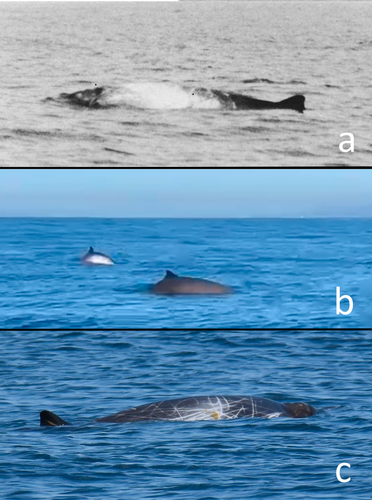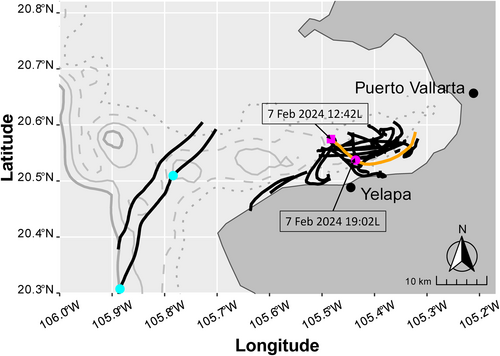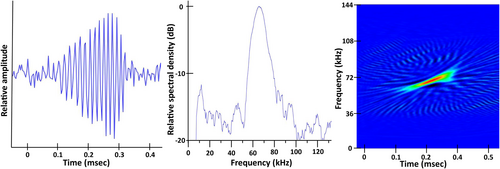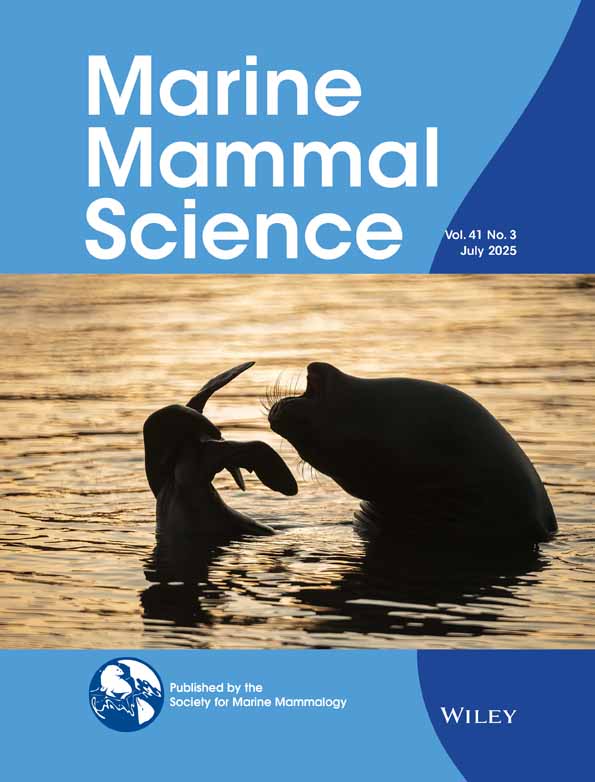Caller ID: Pygmy Beaked Whale Mesoplodon peruvianus Confirmed as the Source of “BW70” Acoustic Signal in the Eastern Pacific
Funding: This work was supported by the Oregon State University.
The pygmy beaked whale (Mesoplodon peruvianus) became known to science relatively recently even though the distinctive pigmentation pattern of the adult males makes it one of the easiest mesoplodonts to identify in the field (Jefferson et al. 2015). The first recorded live sighting of this species was at sea on 16 February 1979 during an extended series of marine mammal survey cruises conducted by NOAA Fisheries in the eastern tropical Pacific (ETP; RLP pers. obs.). Biological observations and a field description of pygmy beaked whales were subsequently published based on two dozen sightings in the ETP (Pitman et al. 1987). However, because the diagnostic adult male color pattern did not match any known species of Mesoplodon at the time, by 1980 field observers had begun referring to it as “Mesoplodon sp. A,” a name that eventually worked its way into published literature (e.g., Urbán-Ramírez and Aurioles-Gamboa 1992; Carwardine 1995; Pitman and Lynn 2001; Ceballos et al. 2005).
Reyes et al. (1991) formally described M. peruvianus as a new species based on 10 specimens captured or stranded in Peru between 1976 and 1989. Citing several lines of evidence, Pitman and Lynn (2001) suggested that “sp. A” and M. peruvianus were the same species, but this was not confirmed until 2013 when a stranded Mesoplodon with the “sp. A” color pattern was genetically identified as a pygmy beaked whale (Urbán et al. 2013, 2023). Based on at least 38 stranding records (Reyes and Van Waerebeek 2018; Ortega-Ortiz et al. 2021) and over 85 at-sea sightings from surveys in the eastern and central Pacific (Pitman and Lynn 2001; Hamilton et al. 2009; Pitman and Brownell 2012; Ortega-Ortiz et al. 2021), the pygmy beaked whale appears to be largely endemic to the ETP and is especially abundant in the oceanographic province known as the ETP warm pool, which extends offshore from Colima, Mexico and southeast to the Costa Rica Dome (Fiedler and Talley 2006). The second most common mesoplodont in the ETP, Blainville's beaked whale (Mesoplodon densirostris), has rarely been identified at sea in the ETP warm pool (Pitman and Lynn 2001; Hamilton et al. 2009), and only a handful of strandings have been found there (Ortega-Ortiz et al. 2021; Ortiz-Wolford et al. 2021). [Correction added on May 6, 2025, after first online publication: Reyes and Van Waerebeek (2018) has been replaced with Reyes et al. (1991) in the following sentence “Reyes and Van Waerebeek (2018) formally described M. peruvianus....”.]
The first known photograph of a live pygmy beaked whale at sea was taken in Bahía de Banderas, Mexico, on 14 August 1983 at 20.52° N 105.62° W (Pitman et al. 1987; Figure 1a). In addition, there have been at least five other sightings of this species in this bay: a dedicated beaked whale research cruise (Barlow et al. 1997) observed a pair during on 4 October 1995 at 20.55° N 105.41° W; Romo-Sirvent (2004) reported three sightings (and one stranding) from 1988 to 2003 that were classified as either pygmy beaked whales or Mesoplodon sp. A.; and, more recently, video footage was taken during a commercial whale-watch trip on 12 January 2023 at 20.56° N 105.39° W (Figure 1b). These sightings were all within 10 km of the southern shore of the bay and over a deep submarine canyon (to ~1500 m) that runs along the south side of the bay (Figure 2). Bahía de Banderas is within the core distribution area of the pygmy beaked whale and with several confirmed sightings relatively close to shore, it appeared to offer a rare opportunity to conduct nearshore research on a largely unknown beaked whale.


Baumann-Pickering et al. (2014) attempted to match recordings of species-specific, frequency-modulated echolocation pulses (FM pulses) from beaked whales in the central and eastern North Pacific to the species that produced them. Although three of the calls that they reviewed could not be unambiguously assigned, by comparing the stranding and sighting records of the unassigned species to the call distributions, they concluded that the signal known as “BW70” was probably attributable to the pygmy beaked whale given that the recording was made offshore of Punta Pescadero, in the southern Gulf of California, Mexico (Baumann-Pickering et al. 2014), a place where the pygmy beaked whale is the only mesoplodont regularly seen (Barlow et al. 1997; Cárdenas-Hinojosa 2008).
In February 2024, we conducted a shore-based study in southern Bahía de Banderas to confirm whether the acoustic signal known as BW70 is produced by the pygmy beaked whale. Visual and acoustic searches for pygmy beaked whales were conducted in Bahía de Banderas using a panga (an 8-m open, outboard-powered, fiberglass-hull boat) operated out of Yelapa, Jalisco, Mexico, during 1–10 February 2024. A team of 3–6 cetacean researchers searched by the naked eye for beaked whales and other cetaceans when conditions permitted, typically in Beaufort 0–4 conditions. Visual transects were not planned in advance and were conducted in the deep-water habitat of Banderas Canyon (Alvarez 2007), wherever sighting conditions were best on a given day. Two drifting buoys with acoustic recorders (Soundtrap ST300HF, Ocean Instruments, New Zealand) suspended 8–10 m below the surface were typically deployed at the end of each search day and allowed to drift overnight with the currents (Figure 3). Buoys were also deployed for shorter daytime drifts on some days to provide additional geographic coverage. Drifting buoys were tracked with satellite-based geo-location devices (SPOT Trace, Globalstar Inc., Covington, Louisiana, USA and SmartOne Solar, Globalstar Inc., Covington, Louisiana, USA), and their recovery was aided by VHF-based geo-location devices (Garmin DC40, Garmin Ltd., Olathe, Kansas USA). Acoustic signals were recorded continuously during each drift with a sampling rate of 576 kHz. Recordings from the previous day and night were reviewed the next evening to determine whether beaked whales had been detected.

Acoustic recordings were processed with PAMGuard software (version 2_01_05, Gillespie et al. 2009) to identify cetacean echolocation signals with its “Click Detection” module. Impulsive sounds were classified based on peak frequency using the PAMGuard “Click Classification” module. After pre-processing with PAMGuard, the PAMGuard Viewer software was used to visually search for FM pulses from beaked whales. Within PAMGuard Viewer, the “Matched Template Classification” module was used to highlight pulses that had a high waveform correlation with templates of idealized beaked whale echolocation signals, including the goose-beaked whale (Ziphius cavirostris), dense-beaked whale, and BW70. Detected signals were viewed in a “Click Detector” window, coded by distinctive colors and shapes based on the peak frequency and matched template classifications. The PAMGuard settings file (psfx format) used in this signal processing is available from the first author on request.
One group of three pygmy beaked whales (Figure 1c) was seen and photographed at 12:42 local time [UTC-6] on 7 February 2024 at 20.575° N 105.483° W; no other beaked whales were seen during our visual searches. One drifting buoy recorder was deployed at the sighting location at 12:48, ~4 min after the whales surfaced, and three other drifting buoy recorders were deployed within 3 km of the sighting location in the following 3 h. All buoy recorders were recovered the next day. Twenty-two upswept echolocation pulses that closely matched the previously described BW70 signal were recorded from 19:02 to 19:10 local time (approximately 6.5 h after the sighting) on the buoy recorder deployed at the sighting location. The location of the buoy recorder at the time of the BW70 signals was 20.537° N 105.436° W, 5.3 km southeast of the sighting location (Figure 3). The only other beaked whales recorded during our study were two acoustic detections of goose-beaked whales on 5–6 February 2024, from recorders that were drifting outside of Bahía de Banderas (Figure 3) over the deeper canyon segment (1500+ m) that runs North–South, perpendicular to the canyon segment that extends into Bahía de Banderas.
The 22 upswept echolocation pulses were recorded over an 8-min period. All are relatively low-amplitude signals with a maximum signal-to-noise ratio (SNR) of ~18 dB. The strongest signal is illustrated in Figure 4. Of the 21 pulses with a SNR greater than 15 dB, the median peak frequency (66.0 kHz, range = 65–68 kHz), center frequency (65.9 kHz, range = 64.2–66.8), and −10 dB bandwidth (22.0, from 55.0 to 77.0 kHz) for our samples closely match those presented by Baumann-Pickering et al. (2013) in the original description of BW70 (66.4, 66.9, and 23.4 kHz for peak, center and −10 dB bandwidths, respectively). Our median inter-pulse interval (141 ms) is slightly longer than in the original description (119 ms) but is well within the given 80% confidence intervals (92–217 ms) (Baumann-Pickering et al. 2013). The signals we recorded on this occasion are clearly BW70 signals. These recordings are available from the authors on request.

Given the time (6.5 h) and distance (5.3 km) from the sighting to the acoustic detection, we cannot be certain that the group of pygmy beaked whales we observed was the same group that we recorded. However, we covered most of Banderas Canyon during 8 days of visual surveys and 9 days of acoustic recording drifts. During that time, we saw pygmy beaked whales only once, and BW70 signals were recorded only once, both on the same day, making it likely that we saw and recorded the same group.
Other indirect lines of evidence further support our conclusion that the BW70 echolocation pulse type was made by pygmy beaked whales. To our knowledge, no other species of Mesoplodon has been documented in Bahía de Banderas. The bay is within the core of the pygmy beaked whale sighting distribution and is an area where it is the only Mesoplodon commonly seen (Figure 26 in Hamilton et al. 2009). The only beaked whale echolocation signals we detected during this study were from BW70 inside the bay and goose-beaked whale near the steep slope descending into Tehuamixtle Basin, just outside the bay. The location of our BW70 recording was within a cluster of previous pygmy beaked whale sightings in Bahía de Banderas (Figure 3); similarly, the location of the original BW70 recording (Baumann-Pickering et al. 2014) came from an area in the lower Gulf of California where pygmy beaked whale is the only Mesoplodon species that has been reported (Hamilton et al. 2009; Urbán-Ramírez et al. 2012). The peak frequencies of the BW70 signals we recorded are much higher than the echolocation signals of goose-beaked whales (40 kHz) and dense-beaked whales (34 kHz) (Baumann-Pickering et al. 2013), the only other species likely to be in this area.
Considering the paired sighting and acoustic recording were relatively close in time and space, along with multiple lines of circumstantial evidence, we are confident in confirming the earlier assertion of Baumann-Pickering et al. (2014) that the pygmy beaked whale is the source of the BW70 echolocation pulse. This is important because passive acoustics and the BW70 signal can now be used to study the distribution and abundance of what is normally a difficult-to-detect and almost completely unknown species of cetacean.
Acknowledgments
We thank Shannon Rankin, NOAA Fisheries, and John Atkins, Ocean Instrument, New Zealand, for the loan of ST300HF recorders. Javier “Don Fity” Lorenzo operated our panga and provided valuable logistic support. Roberto Rodriguez aided in recovering one of our buoy recorders that had been picked up by a local fisherman. We thank Roman Álvarez for providing high-resolution bathymetry data of Banderas Canyon. Research was conducted under Mexico research permits SPARN/DGVS/12928/23 (from SEMARNAT to Gustavo Cárdenas H., CONANP) and SPARN/DGVS/01835/24 (from SEMARNAT to Jorge Urbán R, UABCS). Research was approved by the Oregon State University Institutional Animal Care and Use Committee under protocol #IACUC-2023-0388.
Conflicts of Interest
The authors declare no conflicts of interest.
Open Research
Data Availability Statement
The data that support the findings of this study are available on request from the corresponding author. The data are not publicly available due to privacy or ethical restrictions.




